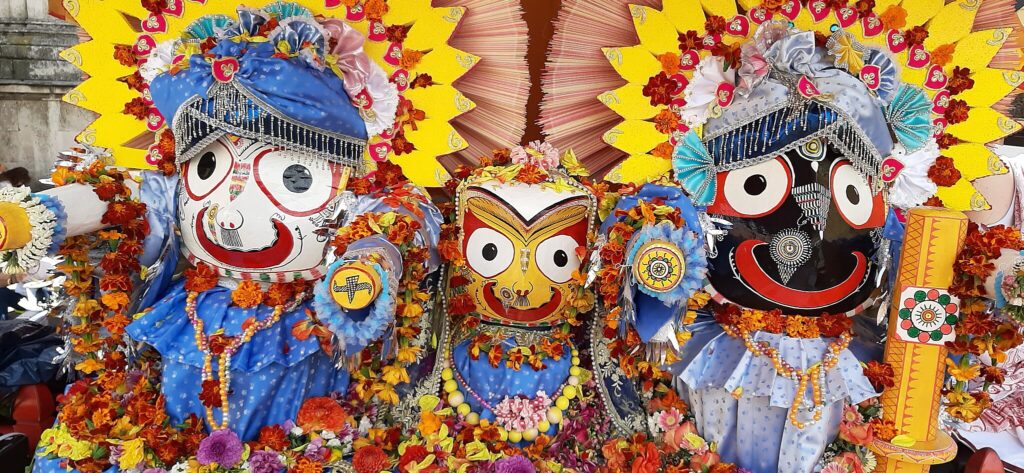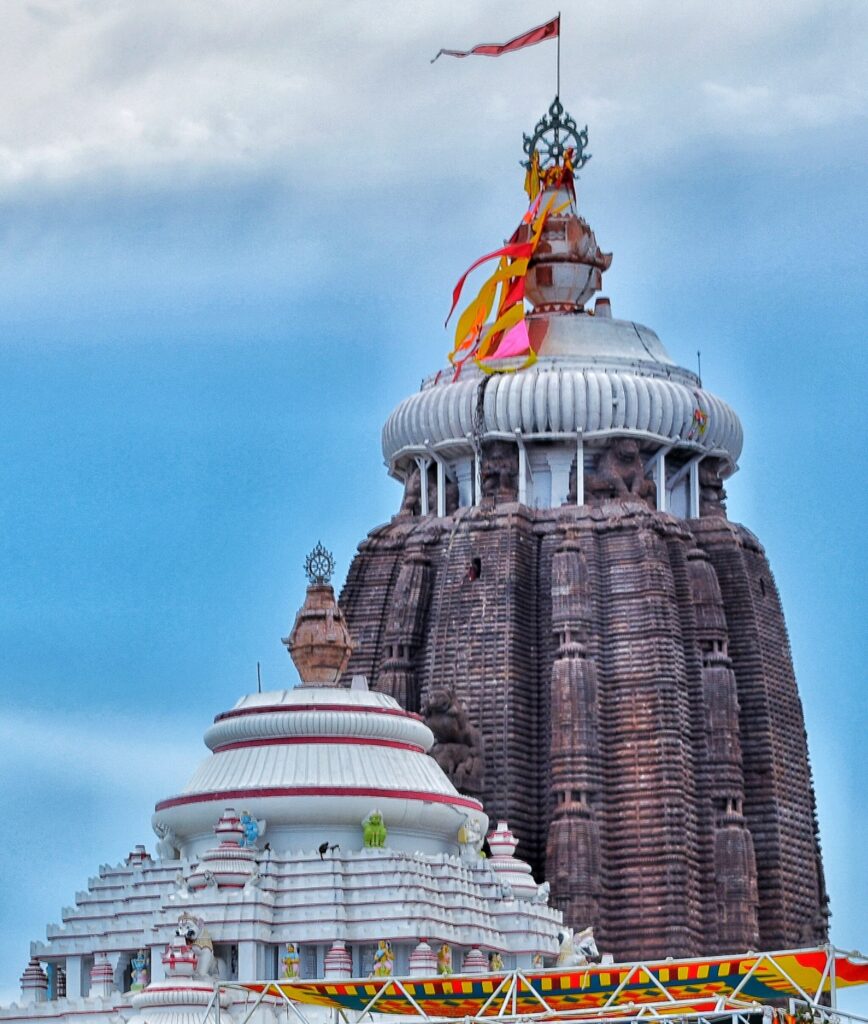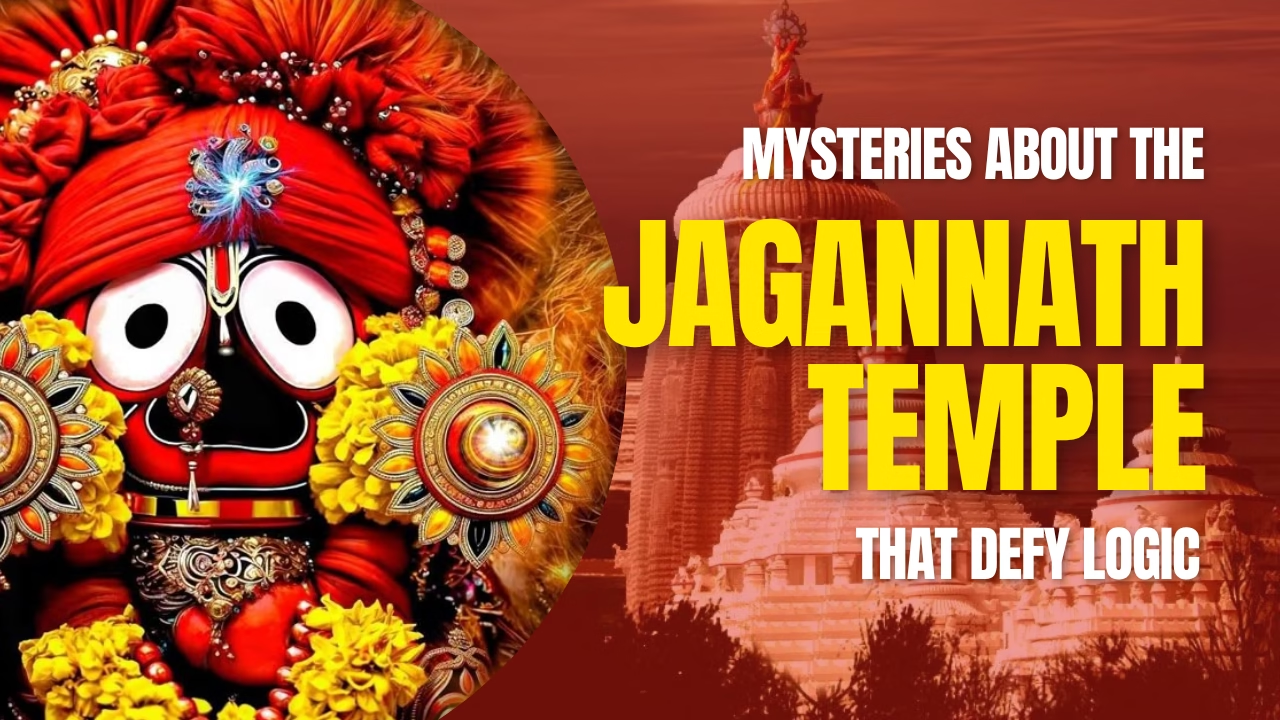The Jagannath Temple of Puri is one of India’s most sacred pilgrimage sites — a place where devotion runs deep, and so do the mysteries. Dedicated to Lord Jagannath (a form of Krishna), this ancient temple isn’t just revered for its religious significance; it’s famous for a series of unexplained phenomena that continue to puzzle scientists, engineers, and spiritual seekers alike.
From a flag that defies wind direction to a temple that casts no shadow, every stone of this 12th-century marvel seems to hold a secret. These aren’t myths passed down in whispers — they’re real, observable occurrences that have stood the test of time. Whether you’re a believer, a skeptic, or just curious, the mysteries of Jagannath Temple invite you to experience something beyond the ordinary.
Let’s dive into the most astonishing wonders of this sacred space — where faith, physics, and folklore intersect in the most unexpected ways.
Table of Contents
The Flag That Flies Against The Wind
One of the most iconic sights at the Jagannath Temple is the holy flag (Patitapavana Bana) flying high above the main dome. But here’s where things get strange — the flag always flutters in the opposite direction of the wind. No matter which way the breeze blows, the flag seems to resist it, flowing inward instead of outward.
This isn’t an occasional event — it happens every single day, without fail.
Every evening, a designated priest climbs the temple — which is taller than the Qutub Minar — without safety gear, to change the flag. This daily ritual has continued for centuries and is believed to be essential to the temple’s spiritual protection. If the flag is not changed even for a single day, locals believe the temple must be closed for 18 years.
Despite various theories, no scientific explanation has been able to fully justify this phenomenon. Some say it’s the unique shape of the structure or the coastal air pressure. Others believe it’s a divine sign — a constant reminder that Lord Jagannath is beyond the laws of nature.
Whatever the reason, this mystery remains one of the most visually stunning and symbolic aspects of the temple.

Image Credit: no bias — קיין אומוויסנדיקע פּרעפֿערענצן — keyn umvisndike preferentsn, CC BY-SA 4.0 via Wikimedia Commons https://commons.wikimedia.org/wiki/File:Rath_Yatra_in_Munich_2020,_the_siblings_Balarama,_Subhadra_and_Lord_Jagannath_20200725_160916.jpg
The Shadowless Temple
Imagine a structure over 200 feet tall casting no shadow on the ground — sounds impossible, right? Yet that’s exactly what devotees and visitors notice at the Jagannath Temple. Despite the blazing sun overhead, the main dome (Shikhara) appears to have no visible shadow at any time of the day.
The temple’s architecture is ancient and astonishingly precise. Some say the design and dome curvature are responsible for dispersing the shadow evenly, making it appear as if there’s none at all. But no detailed architectural blueprint has fully explained how this works — especially since the temple was built centuries ago without modern tools or calculations.
Devotees see it differently. To them, it’s not just an optical illusion — it’s a divine message, reminding us that in the presence of the divine, even light and shadow lose their usual meaning.
Whether it’s a clever architectural trick or something more mystical, the shadowless temple continues to fascinate all who visit.
When Winds and Waves Reverse Their Roles
If you’ve ever been to a coastal area, you know the routine: sea breeze flows inland during the day, and by night, the direction reverses as land breeze heads back to the sea. But not in Puri.
Here, near the Jagannath Temple, this natural cycle seems to flip. During the day, the breeze flows from land to sea, and at night, it moves from sea to land — the exact opposite of what science predicts.
Puri lies on the eastern coast of India, where the Bay of Bengal meets the land. Meteorologists and scientists have observed this strange reversal, but no clear explanation has been pinned down. The temple’s location, structure, and alignment are believed by some to influence local wind patterns — yet how this happens is still a subject of debate.
For devotees, this reversal is seen as another sign of the Lord’s presence. It’s believed that the winds themselves follow Jagannath’s will, not earthly rules. When everything around the temple — even the wind and sea — seems to behave differently, it’s no wonder this site is called one of the most mystical places in India.
The Top Pot Cooks First
Every day, the Jagannath Temple kitchen feeds over a hundred thousand people — making it one of the largest kitchens in the world. But what amazes visitors and scientists alike is how the food is cooked.
Here’s the surprise: seven clay pots are stacked one on top of another over a wood fire, and the pot at the top cooks first, followed by the second, and so on — completely defying the basic laws of heat transfer.
According to logic, the bottom pot should receive the most heat, right? But not in this temple. The top-most pot, placed farthest from the fire, is always the one that finishes cooking first. Even local chefs and engineers are unable to explain how this works — and the temple continues to use the same age-old method every single day.
The food prepared here isn’t ordinary. It becomes Mahaprasad, blessed by the Lord himself, and is shared among devotees as a sacred offering. Some say that the divine energy of the temple itself influences the cooking process — a sacred mystery that no amount of science has unraveled so far.
No Flights Over the Temple
Look up at the sky above the Jagannath Temple — and you’ll notice something strange. No airplane or even a bird ever flies directly over the temple. In a modern world where air traffic is constant and unpredictable, this stands out.
Interestingly, there is no officially declared “no-fly zone” over the temple. Yet, pilots and observers have long noted that aircraft naturally avoid flying above it. Even birds — which are otherwise everywhere in temple towns — seem to steer clear of the sky directly above the temple’s central dome.
Some suggest this might be due to magnetic effects or wind patterns created by the temple’s unique structure, while others call it pure coincidence. But with no technical barrier or restriction, the phenomenon remains an open question.
Believers say it’s the will of Lord Jagannath — no living being is allowed to be above the Lord’s head. The sky above the temple is considered sacred space, untouched and reserved for the divine alone.
Whatever your belief, the silent sky above the Jagannath Temple continues to be one of its most quietly powerful mysteries.
No One Can Sleep Inside the Temple
Despite the temple’s massive size and secure interior, no one is allowed to sleep inside the Jagannath Temple at night — not priests, not guards, not even the king in ancient times. And it’s not just a rule — it’s a tradition backed by strange, unexplained experiences.
After the final rituals of the day, the doors to the inner sanctum are closed. From that moment onward, the temple belongs only to the Lord. Anyone who has ever attempted to stay overnight inside — whether knowingly or by mistake — has reportedly experienced severe discomfort, fear, or even mental distress.
Stories have been passed down through generations of individuals who tried to challenge the rule and had to be rescued in panic — or were never the same again.
According to temple tradition, Lord Jagannath is said to rest in solitude at night. Human presence during these hours is considered disrespectful to the divine energy residing there. As a result, the temple remains completely empty, yet spiritually full, until the doors open again at dawn.
This sacred restriction adds to the aura of mystery and reverence surrounding the temple, reminding everyone that some spaces are meant only for the divine.

Image Credit: Prachites, CC BY-SA 3.0 via Wikimedia Commons
https://commons.wikimedia.org/wiki/File:Shri_Jagannath_temple_(cropped).jpg
The Sudarshan Chakra Faces You — From Every Direction
Atop the main dome of the Jagannath Temple sits the Sudarshan Chakra — a sacred symbol representing Lord Vishnu’s divine weapon. Made of metal and about 20 feet in diameter, it isn’t just a religious emblem — it’s part of one of the temple’s most fascinating illusions.
No matter where you stand around the temple, the Chakra appears to be facing you directly.
Walk around the temple — from north to south, east to west — and you’ll feel like the Chakra is always looking right at you. It’s not rotating. It’s not moving. But somehow, it maintains visual alignment from all angles.
This isn’t just a tourist trick. Architects and scientists have studied this illusion for years, and most agree it’s due to the precise placement and symmetry of the Chakra and the dome on which it stands. Still, to the human eye, the effect feels magical.
For devotees, this is symbolic of the ever-present gaze of the divine — a reminder that Lord Jagannath sees and protects all, everywhere, equally. Whether you’re near or far, in front or behind, you are never out of his sight.
It’s one of those rare cases where geometry meets spirituality, creating a silent spectacle in the sky.
The Roar of the Sea Disappears Inside the Temple
Standing near the Jagannath Temple, you’ll hear the mighty Bay of Bengal roaring in the background — a constant, thunderous sound that fills the coastal air. But the moment you step through the Singhadwara (Lion Gate) and enter the temple complex, something almost magical happens:
The sound of the sea vanishes.
It’s not a gradual fade — it’s instant. Just a few steps inside, and the powerful ocean seems to go completely silent. This isn’t just noticed by a few; thousands of visitors experience it every day, and many walk back and forth just to feel the difference.
The temple is only a short distance from the sea, and there are no large hills, barriers, or noise-blocking walls. Acoustically, this silence shouldn’t exist — but it does.
Some researchers suggest it might be due to the temple’s unique structure, which could be absorbing or redirecting the sound waves. Others think the high walls and specific layout near the entrance act like a natural noise buffer. But again — there’s no official explanation that fully accounts for the effect.
For the faithful, the silence is meaningful. It symbolizes leaving the outside world behind, stepping into a space where only the divine matters. It’s as if the temple gently asks you to tune out the world and tune in to the sacred.
Mahaprasad Never Goes to Waste
Every single day at the Jagannath Temple, massive quantities of food are prepared — enough to feed up to a hundred thousand people. The offerings, known as Mahaprasad, are cooked using age-old methods in earthen pots over a wood fire.
But here’s the real mystery: no matter how many visitors arrive, the food is always just enough. Not too little. Not too much. And never wasted.
The temple doesn’t operate on reservations or digital tracking. There’s no advance list of how many people will eat that day. Still, the cooks — guided by tradition and intuition — prepare the perfect amount. If the footfall is high, the food stretches. If it’s low, only what’s needed is cooked.
Even more amazing? Leftovers are unheard of.
Mahaprasad is served without discrimination — everyone eats the same food, whether you’re rich or poor, local or outsider. It’s more than just a meal. It’s a spiritual blessing, believed to carry the grace of Lord Jagannath himself.
Devotees believe that the Lord ensures no devotee goes hungry, and that food blessed by him will never be wasted. It’s a tradition that has continued flawlessly for centuries — without technology, but with faith.
Final Thoughts
The Jagannath Temple is more than an architectural wonder or a religious monument. It’s a living mystery — where wind flows backward, shadows vanish, and the divine seems to bend the rules of nature. These mysteries may never be fully explained, but perhaps they’re not meant to be.
Because in the world of Lord Jagannath, faith begins where logic ends.
Curious about more hidden wonders of India? Explore our collection of untold stories and ancient secrets here.
Frequently Asked Questions – FAQ
1. Why does the Jagannath Temple flag fly against the wind?
Discover the mystery behind how the temple’s sacred flag defies natural wind direction every single day.
2. Is it true that the Jagannath Temple casts no shadow?
Yes — the main dome of the temple is said to cast no visible shadow, and here’s why it continues to amaze visitors.
3. Why are people not allowed to sleep inside the Jagannath Temple?
According to tradition, no one can stay overnight inside the temple — and those who’ve tried report strange effects.
4. What is the mystery of the Sudarshan Chakra on Jagannath Temple?
No matter where you stand, the Sudarshan Chakra seems to face you. Learn how this optical illusion works.
5. Why is Jagannath Temple food (Mahaprasad) never wasted?
Despite feeding thousands, the food never runs short or goes to waste — a mystery that defies all logic.
6. Is the Jagannath Temple in Puri a no-fly zone?
Officially no — but strangely, aircraft avoid it. Here’s what makes the sky above the temple unique.
7. How is food cooked in the Jagannath Temple kitchen?
Seven pots are stacked, yet the top one cooks first. Here’s how this ancient kitchen challenges modern science.
8. What happens inside Jagannath Temple at night?
Once the doors close, the temple is left completely empty — no one is allowed to stay inside until morning.




Hi there Dear, are you actually visiting this web page on a regular basis, if so after that you will definitely get good know-how.
WOW just what I was searching for. Came here by searching for %meta_keyword%
Howdy would you mind sharing which blog platform you’re using? I’m looking to start my own blog in the near future but I’m having a tough time deciding between BlogEngine/Wordpress/B2evolution and Drupal. The reason I ask is because your design seems different then most blogs and I’m looking for something unique. P.S My apologies for getting off-topic but I had to ask!